Ways Health Departments Can Help Increase COVID-19 Vaccinations

Find strategies and resources for health departments and community leaders to use when planning and implementing activities to generate demand for COVID-19 vaccinations. These include guidance for building COVID-19 vaccine demand in different settings and tips for how to build trust, address misinformation, and tailor messages and materials.
Increasing COVID-19 vaccinations requires easily accessible vaccines and meeting people where they are with compelling information from trusted sources. Below are best practices to consider implementing to help increase COVID-19 vaccinations where people live, work, learn, pray, play, and gather.
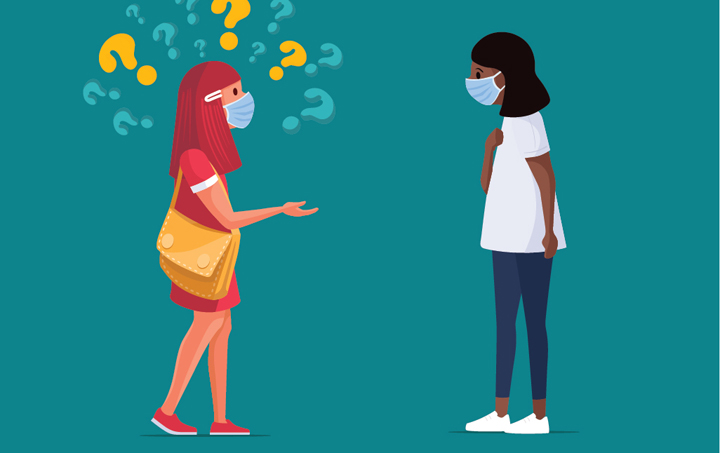
- Recruit staff and volunteers to go to communities with low vaccination rates to talk with people about vaccinations for themselves and their loved ones, answer their vaccine questions, and schedule their vaccination appointments.
- To identify communities of focus, refer to the CDC’s Social Vulnerability Index and the American Immunization Registry Association’s guide on Identifying Immunization Pockets of Need.
- Equip volunteers with handouts (in the target population’s language) with local vaccination site information and guidance on:
- Consider partnering with local colleges and organizations to offer Malcom X College’s free two-hour online Vaccine Ambassador Course, which provides guidance on how to have conversations about vaccine hesitancy and mistrust.
- Make sure that staff and volunteers speak the same language as those they visit and are considered acceptable by the local community. If possible, to increase trust, they should also be from the same neighborhood or area as the residents.
- Partner with local community groups who know and serve residents to support community outreach. Leverage those who provide services to people who are homebound (such as Meals on Wheels) to help them make a vaccination appointment or request at-home vaccinations.
Strategy in Action: At the start of the pandemic, rural Randolph County, GA had the highest COVID-19 case rate in the state. Even after vaccines became widely available, the county’s vaccination rate was well below the state average. Since March 2021, volunteers volunteers with Randolph County’s Neighbor 2 Neighbor (N2N) Program, who previously conducted voting outreach in the county have been conducting COVID-19 vaccine outreach to answer questions, and book appointments for residents at their local vaccination clinic, helping to increase vaccinations in the county.
- Provide at-home vaccinations to those who have difficulty accessing a vaccination site. Priority populations in your area for at-home vaccinations may include older adults, people with disabilities, people who are homebound, and those in rural communities.
- Partner with local pharmacies, paramedics, and healthcare providers to offer door-to-door vaccination services.
- Set up a hotline and an online form for residents to request at-home vaccinations.
- Refer to CDC’s guidance on:
Strategy in Action: Multnomah County, Oregon Emergency Operations Center partnered with Medical Reserve Corps volunteers and paramedics to vaccinate 1,400 people who were homebound, providing a sense of freedom to older adults and people with disabilities who had been in lockdown for more than a year.
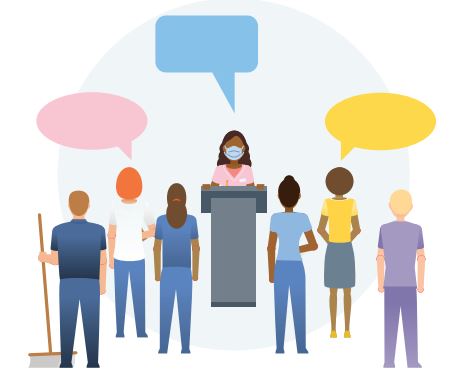
Encourage employers to help employees get vaccinated. Options include allowing employees to be away during work hours or to take paid leave to get vaccinated, reimbursing employees for transportation costs, and offering on-site vaccination. Remind employees that they are entitled to a COVID-19 vaccine regardless of their immigration or health insurance status.
-
- Refer to CDC’s Guide to Vaccinating Workers for 10 steps to vaccinate workers.
- If you discover unmet demand for vaccinations after typical service hours, partner with local pharmacies or vaccination sites to offer extended evening or weekend hours.
Strategy in Action: Rising Ground, a New York City-based human services nonprofit, has implemented a variety of COVID-19 vaccine outreach strategies to its employees, including frequent educational workshops on vaccine safety and efficacy, social media campaigns, paid time off to get vaccinated and in case employees they have side effects after vaccination, and on-site vaccinations.
- Partner with local organizations to distribute vaccine information to their business members. Ask employers to become vaccine ambassadors by promoting vaccines within their organization and having vaccine conversations with their employees.
-
- Partners could include:
- Chambers of Commerce
- Rotary Clubs
- American Farm Bureau Federation
- Partners could include:
Strategy in Action: The Greater Miami Chamber of Commerce held virtual Trustee Luncheons using Zoom panel discussions with local leaders, physicians, and businesses about COVID-19 and vaccine distribution. This engaging forum enabled participants to share pertinent information and ideas in an approachable and timely way.
- Host workplace vaccination events in partnership with pharmacies and health groups. For those who work long or odd hours or who cannot take time off work, getting vaccinated at a local pharmacy or clinic is not always possible. Also, minority, migrant, and undocumented workers may avoid vaccination sites due to fear of immigration authorities, distrust in government, and transportation limitations. Encourage these workers’ employers to provide on-site vaccination clinics. This approach is especially effective at factories, construction sites, farms, and food-processing plants.
-
- Identify locally trusted health groups to offer workplace vaccinations, such as a local clinic that serves an immigrant community and has multilingual staff. Help matchmake between businesses that want to offer workplace vaccinations and health groups willing to provide mobile vaccination.
- Refer to guidance on holding safe and effective workplace vaccination programs from:
- CDC’s Workplace Vaccination Program Guidance
- National Institutes of Health’s Key Elements of a Model Workplace Safety and Health COVID-19 Vaccination Program
- Health Action Alliance’s Quick Start Guide: Strengthening Workplace Vaccination & Safety in Response to the Delta Variant
- National Resource Center for Refugees, Immigrants, and Migrants’ Mobile COVID-19 Vaccination Campaign Resources
- CDC’s Mobile Vaccination Resources
Strategy in Action: Merced County Department of Public Health in California partnered with poultry producer Foster Farms and Save Mart Pharmacy to vaccinate 1,000 essential workers. Since September 2020, 370 Foster Farms plant employees tested positive for COVID-19 and nine lost their lives due to COVID-19, making vaccinations a top priority to prevent subsequent outbreaks.

- Build a corps of vaccine advocates in schools. With COVID-19 vaccines available to children ages 6 months and older, ask school leaders — including nurses, teachers, Parent Teacher Association (PTA) members, principals, and superintendents — to be vaccination advocates by sharing their positive vaccination experiences, promoting vaccination events, and distributing vaccination information to teachers, parents, and students through flyers, emails, and newsletters.
Strategy in Action: The Seattle and King County Department of Public Health developed a flyer tailored to students ages 12–17 years that includes vaccination site information, how to prepare for your vaccine appointment, and frequently asked questions. This flyer is available in 22 languages for schools to distribute to students and parents through their communication channels.

- Leverage existing school events, such as PTA meetings, performances, sports tournaments, field days, and other opportunities where many parents and students gather, to educate them about vaccine availability for children ages 6 months and older, answer parents’ questions, or arrange pop-up vaccination sites.
- Hold school-located vaccination events in partnership with school districts, especially those in areas that have a high Social Vulnerability Index score and low vaccination rates. This is a great opportunity to get families’ eligible members vaccinated together in a trusted, familiar, and convenient location.
Strategy in Action: New York City is holding school-located mobile vaccination sites for children and is hosting community conversations with parents, teachers, and students. Organizers started with four schools in the Bronx, which had high numbers of COVID-19 cases and low vaccination rates. The city is adding school sites in Manhattan, Queens, and Brooklyn and establishing sites at schools across the city. This effort, in partnership with the city health department and the United Federation of Teachers union, launched in coordination with the city’s “Youth Vax Week.”

- Ask religious leaders to encourage COVID-19 vaccination. People, especially older adults, trust their religious leaders and believe in what they say and do. Faith-based approaches can increase vaccinations, even among those who have low confidence in vaccinations for themselves or their children.
-
- Ask religious leaders to get vaccinated publicly for others to see, share stories with their congregations of why they chose to get vaccinated, and talk to their members about the benefits of vaccinating the whole family, including being able to congregate inside and sing without wearing masks. Learn how Muslim leaders in Minneapolis worked with the Department of Health to increase vaccine confidence and uptake within the Somali community.
Strategy in Action: The Interfaith Youth Core (IFYC) has been partnering with health departments, health centers, civic organizations, and colleges and universities to train 2,000 people from diverse faith backgrounds to engage in vaccine outreach in their religious communities. IFYC also hosts web content promoting stories of religious community members getting vaccinated and an article series, Faith in the Field, that explores vaccination efforts in various faith communities and offers practical guidance for conducting vaccine outreach.
- Equip faith-based organizations with resources to effectively communicate COVID-19 vaccination information and help people overcome questions and concerns.
- Partner with faith-based leaders to hold vaccination events.
Strategy in Action: In Jacksonville, Florida, Black and African American populations were lagging far behind White populations in vaccinations. In response, the health department partnered with Black and African American churches in areas with low vaccination rates to hold on-site vaccination clinics, which vaccinated 60,000 people.
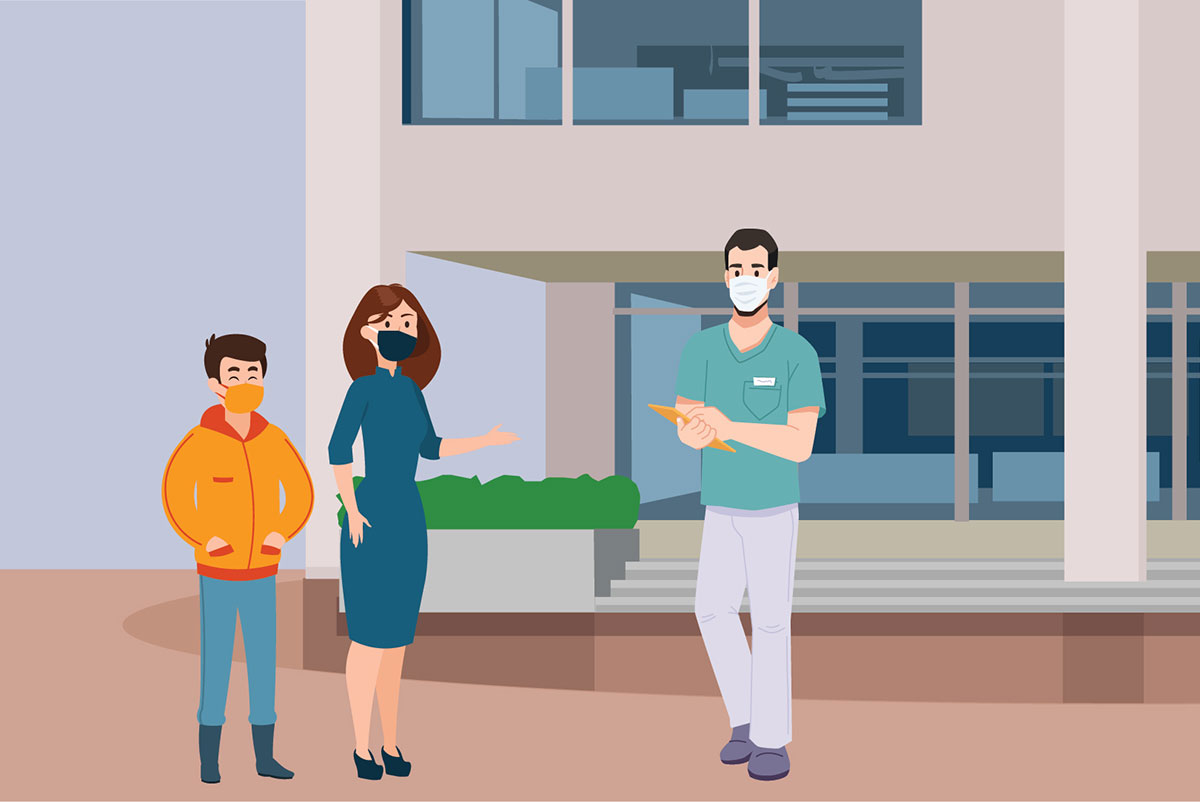
- Hold vaccination events at local parks, barbershops and salons, recreation centers, and community centers, such as YMCAs and Boys and Girls Clubs. Engage trusted community leaders and organizations in promoting and hosting the events to get all eligible family members (ages 6 months and older) vaccinated.
- What to Consider When Planning to Operate a COVID-19 Vaccine Clinic
- Use HHS’s On-Site Vaccination Clinic Toolkit for guidance on how to work with vaccine providers to set up vaccination clinics.
- Coordinate with local barbershops and beauty salons as part of the Shots at the Shop initiative to provide customers with vaccine information and on-site vaccinations in partnership with local healthcare providers.
Strategy in Action: Connecticut and California held mobile vaccination clinics throughout the summer at amusement parks and beaches on a walk-up, no-appointment basis.
- Coordinate education and outreach efforts with community centers and train staff to help community members find vaccination information and locations, as well as book appointments.
-
- Refer to CDC’s Guide for Community Partners to Increase COVID-19 Vaccine Uptake Among Members of Racial and Ethnic Minority Communities.
- Many childcare providers, including Bright Horizons, KinderCare, Learning Care Group, and YMCAs have provided free childcare for parents and caregivers to get vaccinated and recuperate after vaccination.
Strategy in Action: Many YMCAs are offering free drop-in childcare for parents while they get vaccinated. YMCAs also provide communities with vaccine information. Some serve as vaccination centers and partner with public and private entities, including state and local health departments, local pharmacies, and Lyft, to help people get vaccinated.
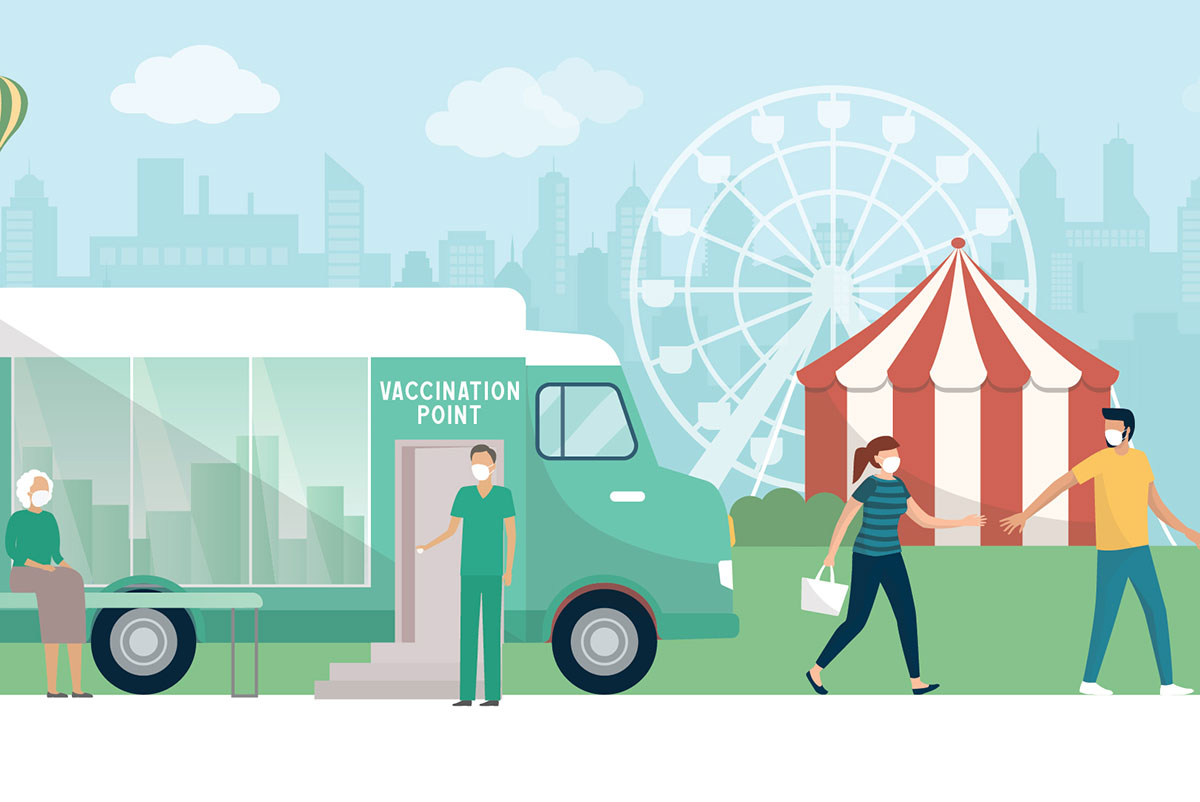
- Coordinate with community organizations to have trusted community members (such as doctors, nurses, health educators, faith-based and community leaders) attend local events (such as fairs, festivals, concerts) as vaccine ambassadors. They can wear “Ask me a question about COVID-19 vaccines” t-shirts, staff a Q&A booth, casually talk to people about the benefits of getting vaccinated, answer questions using CDC guidance, and hand out flyers and vaccine information.
- Equip vaccine ambassadors with smartphones or tablets so they can help people find a vaccination location near them and sign up for an appointment.
- Hold pop-up vaccination clinics at local events, concerts, fairs, and festivals. Partner with local hospitals, pharmacies, and clinics to administer vaccines.
Strategy in Action: The City of Lubbock Health Department (CLHD) partnered with its public transportation provider, Citibus, to hold mobile vaccination clinics at existing local events, offering COVID-19 vaccines and information to event goers. Events included a local school board festival, back-to-school events, a Juneteenth celebration, art fairs, a Fall Fiesta celebration, and local church events. As of August 2021, CLHD used the Citibus mobile vaccination clinics at 29 events and administered 1,400 vaccines.
- Partner with the organizers of well-known cultural or sporting events to hold COVID-19 vaccination events to make the experience fun and inviting for community members.
Strategy in Action: Vaccination events were held in partnership with state health departments and health systems at Kentucky’s Churchill Downs and Alabama’s Talladega Superspeedway. At Talladega’s drive-through event, there was an added incentive for attendees who got vaccinated—they were able to drive a couple laps around the iconic track at highway speed.
For help with how to partner with community groups, refer to CDC’s Guide for Community Partners.
- Work with existing programs that people trust and visit regularly to effectively reach communities with COVID-19 information and vaccines. Working with programs that communities are routinely familiar with can help increase vaccine confidence in those who may mistrust government or health department sources. Ensure existing programs have the capacity and mechanisms in place to distribute information and to vaccinate community members where possible.
-
- Consider programs your community relies on for healthcare, mental health, wellness, food, housing, childcare, education, exercise, and socializing, such as:
- Chronic disease prevention and treatment programs
- HIV and sexually transmitted infection (STI) testing programs
- Mental health and counseling programs
- Substance use disorder prevention and treatment programs
- Food banks
- Housing assistance
- Special Supplemental Nutrition Program for Women, Infants, and Children
- Head Start
- Faith-based organizations
- Consider programs your community relies on for healthcare, mental health, wellness, food, housing, childcare, education, exercise, and socializing, such as:
Strategy in Action: The Mental Health Association (MHA) of Essex and Morris Counties in New Jersey serves 10,000 people annually, including 1,000 patients with severe and persistent mental illness. MHA informed its patients about COVID-19 vaccines through conversations, virtual education sessions, and tailored educational materials. MHA also coordinated with its county governments to host five vaccination clinics, vaccinating clients, staff, and community members.
- Provide program staff with information and messaging about local vaccination sites and COVID-19 vaccines. Program staff can distribute information to community members at their facility, in the field, and virtually through their communication channels. They can help people locate a vaccination site (using Vaccines.gov) or schedule an appointment. Information shared may include:
-
- Handouts in languages preferred by community members
- Key things to know about COVID-19 vaccines
- Benefits of getting vaccinated
- Social media toolkit
- COVID-19 vaccines for children and teens
- COVID-19 vaccine booster shots
COVID-19 fact sheets are available in more than 30 languages from the National Resource Center for Refugees, Immigrants, and Migrants
Strategy in Action: Feeding America and the Blue Cross Blue Shield Association created a Vaccine Awareness Toolkit in English and Spanish for food bank staff and visitors, providing COVID-19 vaccine information from the CDC and other medical experts. They also offer customizable resources for Feeding America food banks to access on the HungerNet SharePoint site (login ID and password required).
- Support existing program staff in having effective vaccine conversations with community members by providing them with tools and resources, including:
- How to talk about COVID-19 vaccines with friends and family
- Answers to frequently asked COVID-19 vaccine questions
- Information to train trusted messengers and community leaders to conduct community-based outreach and education around the COVID-19 vaccines
- Guidance for trusted messengers and community leaders on how to have conversations with community members about the COVID-19 vaccines
This is an opportunity for community members to have conversations about the vaccines in a familiar environment with people they trust. Having a safe space to get their vaccine questions answered and hearing consistent vaccine information from multiple sources may help increase community members’ vaccine confidence.
Strategy in Action: Head Start Early Childhood Learning and Knowledge Center provides staff with Tips for Talking to Head Start Families About the COVID-19 Vaccines. The tip sheet format enables centers to easily print and share with staff, making it easy for staff to reference before or during conversations with families. It includes strategies for helping families make COVID-19 vaccination decisions, a sample script, and links to additional information.
- Consider offering COVID-19 vaccinations with other services offered by existing programs, such as seasonal flu shots, HIV and STI testing and treatment, and blood pressure and blood glucose checks. Offering vaccinations through an existing program enables community members to get vaccinated easily and conveniently without having to go elsewhere.
Strategy in Action: The Sacramento Lesbian, Gay, Bisexual, Transgender (LGBT) Community Center offers COVID-19 vaccination and testing together with other services such as flu shots, HIV testing, and STI testing. These services are delivered onsite and at mobile clinics throughout the city and at events.
Connecting with your communities virtually through trusted messengers is essential to sharing timely information about COVID-19 vaccines and vaccination sites, answering questions, and addressing misinformation. Below are best practices to consider when planning and implementing COVID-19 vaccine online outreach activities tailored to your communities.

- Use and promote trusted content on your social media channels from existing communication and social media toolkits, factsheets, and online resources. These resources include example social media posts, graphics, key messages, and answers to frequently asked questions.
- Refer to the following resources:
- CDC COVID-19 Vaccine Social Media Toolkit
- FDA #VaccineReady Social Media Toolkit
- HHS “We Can Do This” Campaign Resources
- Ways Health Departments Can Help Increase COVID-19 Vaccinations
- Ad Council Community Education Toolkit
- National Association of Community Health Centers’ COVID-19 Communications Toolkit for Health Centers
- Post existing HHS social media messages, graphics, and hashtags on your social media accounts, such as:
- Tailor messages and content and use images that are reflective of your target audience to help increase authenticity and engagement.
- Refer to the following resources:
Strategy in Action: The National Association of Community Health Centers uses its Twitter page to promote its selfie signs and other social media resources.
- Quickly address COVID-19 vaccine misinformation being spread on social media.
- Ask local healthcare professionals and organizations to take questions on social media from patients and community members, promote factual information, and debunk false claims being spread online. Provide them with pre-made graphics and talking points to make it easy for them to post quickly and effectively.
- Post shareable graphics to debunk false claims about the vaccines, leveraging CDC and HHS social media toolkits, CDC COVID-19 Vaccine Myths and Facts, and CDC’s guide to Finding Credible Vaccine Information.
- Link to credible fact checking resources such as Factcheck.org.
- Refer to CDC’s Addressing Misinformation and UNICEF’s Vaccine Misinformation Management Field Guide.
Strategy in Action: New York City Health System partnered with Coney Island Hospital on a social media campaign, #NYCYouthVaxWeek, to combat misinformation about the COVID-19 vaccine and encourage parents to get their children vaccinated. The Twitter post links to in-depth vaccine information, including where and how to get vaccinated.
- Encourage people to share their positive vaccination experiences on social media with a photo, selfie, Instagram story, or TikTok video, and to use buttons, badges, Facebook frames, or hashtags like #WeCanDoThis, #SleeveUp, #COVID19Vaccine, or #JuntosSíPodemosUSA.
- Ask people to share their story of why getting vaccinated is important to them, their families, and what they are most excited about doing once they are fully vaccinated.
Strategy in Action: Michigan Department of Health and Human Services launched a Twitter campaign #MIdoseofhope with videos of residents throughout the state sharing why they got vaccinated—from a woman who lost her mother to COVID-19 to teens who want to go to school dances. The videos are in black and white, are closed captioned, and provide information on how to get vaccinated.
- Promote vaccination site information, pop-up vaccination events, and mobile vaccination locations on your social media channels to encourage people to get vaccinated. Provide location addresses, operation hours, and pre-registration instructions, if required. Ask people to share and re-post.
Strategy in Action: The Chicago Department of Public Health posts upcoming pop-up vaccination locations on Twitter with colorful images and pertinent information, including date, time, location, address, and types of vaccines available.
- Offer social media account takeovers with teen and college-age influencers to reach younger demographics authentically with vaccine information.
Strategy in Action: Pima County Health Department in Arizona incentivized youth to create short videos on social media (TikTok, Instagram, YouTube, and Facebook) through the #VaxTruthChallenge to tell their COVID-19 vaccine stories. The challenge was open to 12- to 24-year-olds and promoted through youth organizations, schools, clubs, and mobile vaccination sites. The goal was to create an opportunity for youth to encourage other youth to get vaccinated through social media.

- Host virtual live events or town halls in partnership with healthcare providers and local community leaders to answer questions about vaccines, share ways to schedule a vaccine appointment, and offer communication strategies to encourage a friend or family member to get vaccinated.
- Events can be held using audio or video conference (such as Zoom or UberConference) or on social media platforms, such as Facebook, Instagram, Twitter, or Clubhouse.
- Include an interactive activity to engage participants, such as using chat and polling features.
- Record events for later viewing on your organization’s website. Offer recordings in bite-size pieces less than a minute long to ease sharing on social media.
- Refer to HHS’s strategies for Facebook Live Events and Webinars for Black/African American Communities for tailored information.
Strategy in Action: Mariposa County Health and Human Services Agency in California hosts monthly Facebook live events led by trusted community physicians who can answer participants’ COVID-19 questions. The county also posts on its website pre-recorded “Talk with the Doc” videos to provide county-specific COVID-19 updates and information. The Los Angeles County Department of Public Health hosted a live Vaccine Town Hall for Parents ahead of the 2021-2022 school year. Public health and medical professionals provided information about COVID-19 protocols in schools and answered parents’ COVID-19-related questions
- Tailor events to your audience to make them inviting and informative. Include your audience’s trusted messengers as presenters or panelists, and ensure information is presented in the languages spoken by the audience.
- If you do not have a healthcare provider or other staff member who speaks the same languages as your audience, partner with a community-based organization serving that audience to co-host the event and provide appropriate language speakers.
- Consider featuring trusted and influential community members, such as a local performer or speaker, to make it fun and generate interest with your target audience.
- Refer to Tailoring COVID-19 Vaccine Messages & Materials for Specific Audiences for guidance.
Strategy in Action: The Cornell Farmworker Program and Finger Lakes Community Health in New York State jointly sponsored a question-and-answer webinar about COVID-19 vaccines in English and Spanish.
- Consider your audience’s technology preferences and abilities when planning your live event, including the platform and time of day.
- For audio or video conference events, offer a phone call-in number for people without fast internet access.
- Ensure that people with disabilities can participate in your virtual meeting by enabling a chat feature and adding closed captions or an American Sign Language (ASL) interpreter.
- Refer to Georgia Tech’s COVID-19 Accessible Resources for guidance.
Strategy in Action: The Detroit Health Department held a live Vaccine Confidence Town Hall conversation via Zoom for individuals with disabilities, which included an ASL interpreter and closed captions.
To help increase demand for COVID-19 vaccinations, it’s critical for health departments to secure their community’s trust. As a health department leader, you can achieve this by fostering strong partnerships with organizations trusted by community members and being responsive to people’s concerns.
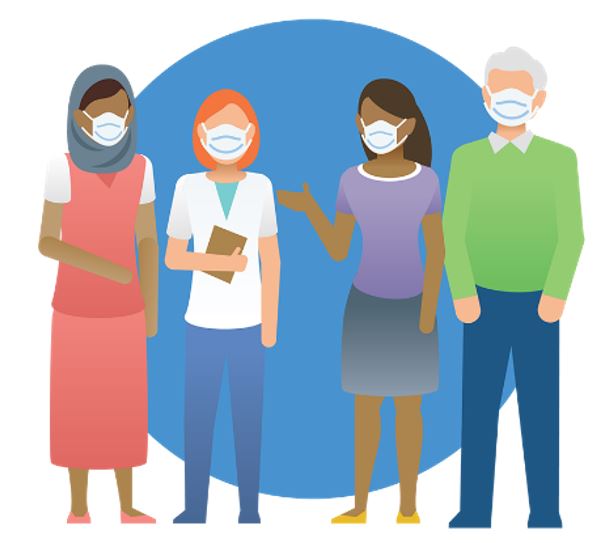
Engaging trusted community messengers is a key strategy for building confidence in COVID-19 vaccines. You may need to engage new types of community organizations that you had not worked with before the pandemic. Here are some tips for engaging new partners:
- Identify the types of organizations that serve groups with low vaccination rates. These could include faith-based organizations, local businesses, youth-serving organizations, food banks, and other social service providers.
- Meet with other government agencies that serve groups you are trying to reach, such as with the Departments of Aging, Recreation, Human Services, Public Safety, Education, and Community Planning. Learn from their strategies and ask for their help in engaging community partners.
- Use resources, such as the Better Business Bureau and Guide Star, to identify potential business partners and their contact information.
- Seek partners that have a large membership base, customer base, or reach (on social media or in person) and are active in the community (e.g., hold regular events, are involved in community activities).
- Approach potential partners with clear communication about the value they offer to COVID-19 vaccination efforts and the benefits of becoming a health department partner.
- Ask your existing partners about their COVID-19 vaccine education and outreach activities. This can help identify successful activities for replication, lessons learned to share with other partners, and potential gaps where you can provide the resources and support that partners might need.
- Engage and support partners in sharing key messages and accurate vaccine information, answering questions, and encouraging vaccination. For example, provide partners with regular talking points, and offer health department staff as speakers at partner events.
- Alert partners to misinformation circulating in the community and equip them with talking points and shareable communication materials to quickly address it.
- Invite partners to co-host community forums to provide safe spaces for community members to ask questions about COVID-19 vaccines. It may be beneficial to hold different events for different populations of focus, like parents of adolescents, people with disabilities, or older adults. These events can be held virtually or in person if the community of focus does not have easy access to technology. An open call for questions before the forum and a report out to the whole community can help reach as many people as possible.
- Invite community partners to host vaccination events. Community members may feel more comfortable getting vaccinated in places that feel safe and familiar to them. Places of worship, businesses, youth-serving organizations, and other partners may be willing to host pop-up or mobile clinics. View the CDC’s Guidance for Planning Vaccination Clinics Held at Satellite, Temporary, or Off-Site Locations. Learn what to consider when planning to operate a COVID-19 vaccine clinic.
- Recognize the contributions of community partners to COVID-19 vaccination efforts. A little recognition can go a long way to building trust with partners and the communities they serve. Feature partners in health department media releases, newsletters, and social media posts, and acknowledge the important role they are playing in protecting their communities.
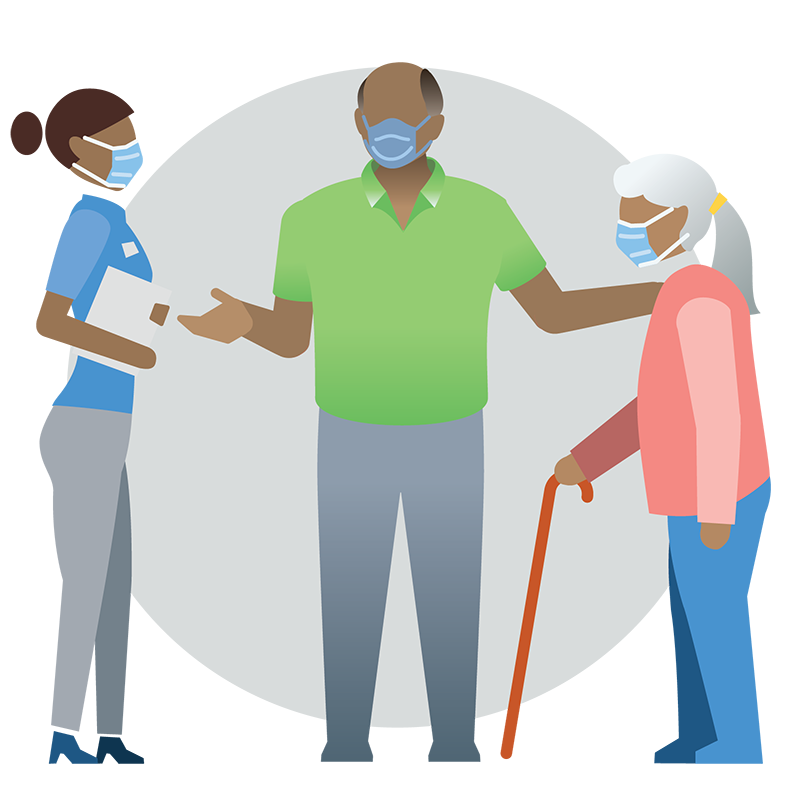
In addition to fostering community partnerships, you can build trust through responsive communication. Below are some tips:
- Communicate clearly and often. It’s important to make sure clear, consistent, and up-to-date information is reaching everyone in the community. Key information to communicate includes:
- How to get vaccinated
- Who can get vaccinated
- Vaccine safety
- Vaccination data
- Ensure it’s easy for people to access and find key information on your website and share information through all available channels in various formats—from social media to direct-mail postcards to street banners to neighborhood forums posts. Also, ensure that the content is written using plain language and is in the right language and reading level for the recipients.
- Identify community members’ common questions about COVID-19 vaccination by analyzing inquiries your department has received through your communication channels. These could include email, website, social media, and call center, in addition to any data you have collected through research, such as surveys or interviews.
- Make it easy for people to find answers to common questions. Show community members that you are listening to them by making answers to their questions easily available on your website, social media, educational materials, and public service announcements (PSAs). If possible, establish a streamlined system to answer questions via phone, text, or virtual chat. Offer “self-help” options such as an updated FAQ web page or an automated phone system that offers answers to basic queries.
- Be transparent. There is a lot of uncertainty and changing information regarding COVID-19 and about COVID-19 vaccination. Be honest about what is known and what is not known, as well as what has changed and why. Acknowledge mistakes and bumps in the road and explain how they will be handled and avoided in the future.
- Empathize with what your communities have experienced. The COVID-19 pandemic has been very stressful for many communities that have lost loved ones, jobs, and housing. Acknowledging these challenges in your communications and outreach is a simple way to make people feel heard and understood.
- Be responsive to community needs and concerns, even if they go beyond COVID-19 vaccination. People trust those who care about them and listen. Although it may not always be possible to meet every need or concern, listening and trying to help can go a long way in fostering trust. If there are concerns that your immunization program cannot address, connect the communities with other departments in your local government that may be able to help.